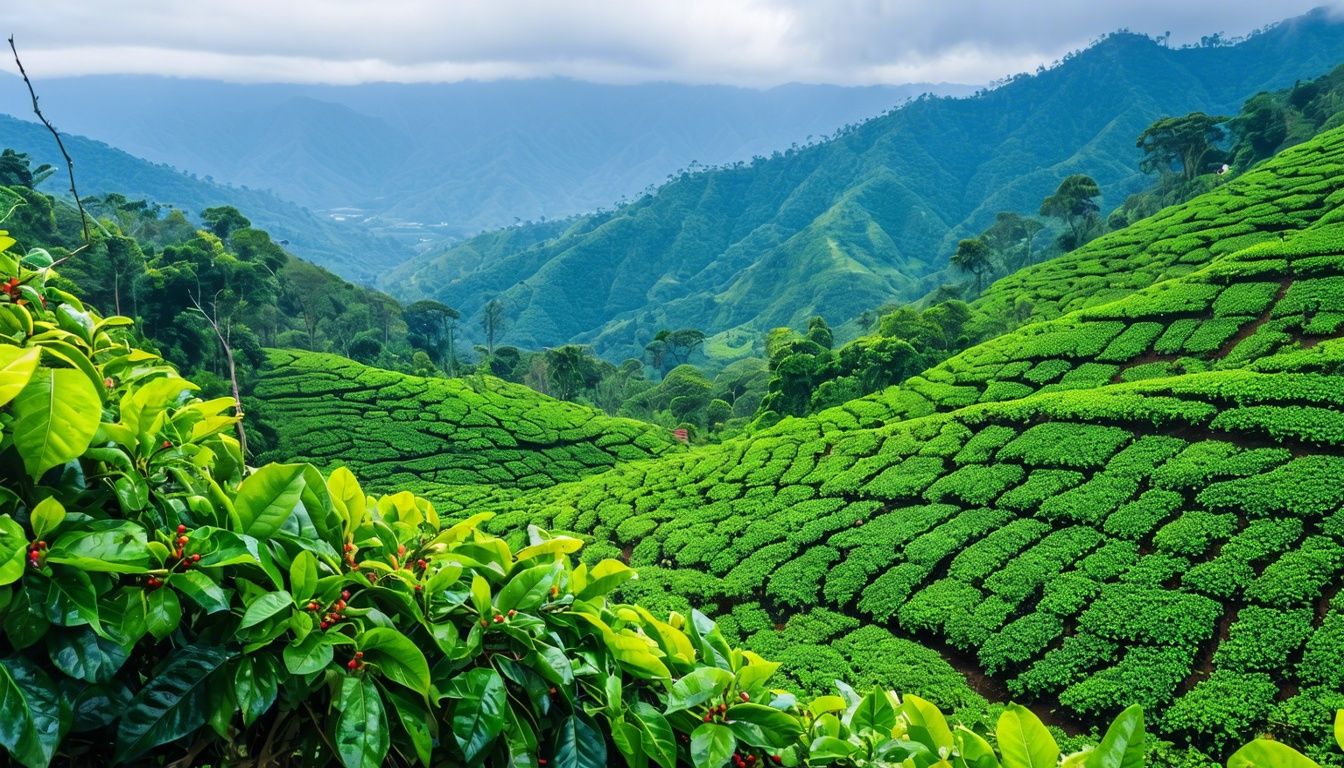Blog
Arabica vs Colombian Coffee
You love a good cup of coffee in the morning. But do you know the difference between Arabica and Colombian coffee? Let’s get straight to it. Arabica beans grow high up, from 500 to 2,000 meters, giving them a range of tastes like vanilla and fruit.
Colombian coffee is special. It’s also Arabica but grows in Colombia at 1,200 to 1,800 meters. This gives it a smooth taste with rich smells and less bite.
The weather and land in Colombia make their coffee taste unique compared to other Arabicas. They clean the beans well, making them taste fresh and bright. When roasting these beans, medium to dark is best for Arabicas to bring out their flavours; light roasts work great for Colombians’ fruity notes.
For brewing, an espresso machine makes Arabica bold and tasty; softer methods like Aeropress or pour-over are perfect for Colombian coffee’s complex flavour profile. Even though they’re both Arabicas—Arabicas have about 30-50 milligrams of caffeine per shot—Colombian can sometimes have less.
Both face climate changes that could mess up production but people are finding ways to keep making great coffee in the future. Ready to see which one you’ll brew next?
Origin and Growth Conditions of Arabica and Colombian Coffee

Arabica coffee comes from plants that love high places. They grow best between 500 and 2,000 metres above sea level. These plants have thin branches and oval leaves with small white blooms.
Now, let’s talk about Colombian coffee. It’s a type of Arabica grown in Colombia’s unique spots at heights of 1,200 to 1,800 metres. This land has special climate and soil that make the coffee taste amazing.
In Colombia, the mountains and volcanic soils help create perfect conditions for these beans. Each bean gets what it needs to develop its own special flavour and aroma thanks to this environment.
So when you drink Colombian coffee, you’re enjoying something truly shaped by its home.
Impact of Elevation and Climate on Coffee Varieties
Elevation and climate play big roles in how your coffee tastes. Coffee plants grown at an elevation of 1,200 to 1,800 metres, like those in Colombia, develop flavours that are smoother and richer with less acidity.
This height makes the coffee beans grow slower. Slow growth gives the beans more time to take in flavour from their surroundings. Sunlight, temperature, and rainfall also change how these beans taste.
In areas with high altitude conditions and volcanic soil, such as where Arabica coffee thrives, you get a special flavour too. These conditions are perfect for Arabica beans because they add desirable flavours and aromas.
Consider this – the same kind of coffee plant can taste very different depending on where it grows. Elevation and climate decide a lot about your morning cup’s aroma and flavour profile – from smooth and rich to vibrant with acidity.
Coffee Processing Techniques in Colombia and Arabica Regions
Coffee beans go through unique processes before reaching your cup. Different regions use various methods to highlight the best flavours.
- Colombia is famous for its washed processing. This method involves removing the coffee bean’s fruit layer with water. The extra washing step adds skill and labour but results in a clean, bright flavour profile.
- Dry processing is common among Arabica coffees from Africa. Beans dry in the sun with their fruit layers on, leading to robust and earthy flavours.
- Colombian beans often undergo an additional washing step not found in other coffee-producing areas. This thorough cleaning might enhance their nutritional value, adding another reason for their unique taste.
- Fermentation plays a role in both regions but under different conditions. In Colombia, controlled fermentation happens after washing, which refines sweetness and acidity. For Arabica coffees from places like Ethiopia, natural fermentation occurs as the beans dry in the cherry, influencing complex fruit notes.
- Roasting brings out distinct characteristics of each region’s beans. Colombian coffees are typically roasted to emphasise their innate brightness and balance while preserving those nuanced flavours created during processing.
- Elevation and climate influence these processes heavily; with Colombia’s high altitudes favouring slower bean development and brighter acidity—ideal for washed processing—while Africa’s diverse climates allow for both washed and dry-processed Arabicas showcasing a broad spectrum of flavours.
Each process highlights what makes coffees from these regions special; whether it’s the labour-intensive washing of Colombian beans or the natural drying methods used across Eastern Africa that bring out deep, wine-like notes in Arabica coffees.
Comparing Flavour Profiles: Arabica Vs Colombian
Let’s break down the distinct flavour profiles of Arabica and Colombian coffee. These differences highlight why each has its own set of fans.
| Feature | Arabica Coffee | Colombian Coffee |
|---|---|---|
| Origin and Growth Conditions | Grows between 500 and 2,000 metres, thriving in high elevations. | Specifically grown in Colombia, between 1,200 to 1,800 metres. |
| Flavour Complexity | Offers a wide range of flavours: vanilla, caramel, fruits, and spices. | Well-rounded with balanced acidity, fruity flavours, and floral aromas. |
| Acidity | Milder acidity compared to other beans. | Smooth, with a more noticeable but balanced acidity. |
| Body | Light to medium, enhancing its diverse flavour profile. | Medium, providing a rich texture. |
| Caffeine Content | Lower, contributing to its milder taste. | Similar to Arabica, but growing conditions can alter the content slightly. |
| Roasting Preference | Medium to dark, to highlight its range of flavours. | Lighter roast preferred to maintain its unique profile. |
| Brewing Methods | Espresso machines extract bold flavours well. | Aeropress, pour-over, and drip to emphasise fruity and floral notes. |
Each coffee type presents a unique taste experience. Arabica beans offer a broad spectrum of flavours, from sweet to spicy, while Colombian coffee beans, a type of Arabica grown under specific conditions, brings a rich, smooth cup with a hint of fruit and flowers. Your choice depends on your flavour preference and the kind of coffee experience you seek.
Analysis of Acidity and Body in Arabica and Colombian Coffe
Arabica coffee beans have a mild acidity and a wide range of flavours. This comes from the bean’s specific growing conditions. The less caffeine in Arabica also makes its taste milder.
On the other hand, Colombian coffee gives you a balanced acidity. This balance comes from Colombia’s unique climate and soil. Such conditions make Colombian coffee smoother and richer compared to other Arabicas.
Colombia’s environment plays a big role here. It helps create that smooth, rich taste with less bite than you might find elsewhere. So, if you enjoy your coffee with more body but not too sharp on the tongue, Colombian varieties are for sure worth trying out.
Differences in Caffeine Content between Arabica and Colombian Coffee
Arabica coffee has around 30-50 milligrams of caffeine per espresso shot. This type is known for a bit more caffeine than Colombian coffee. But, Robusta coffee beans pack much more—a whopping 1.7x to 2.25x the amount in Arabica.
So, if you choose Colombian brews, expect them smoother with less kick from caffeine.
This matters when picking your morning drink or for those late-night sessions when you need an uplift without too much buzz. Each cup offers a different level of wakefulness—Colombian varieties bring you up gently, while other Arabica bean types have that extra bit to get things moving quicker.
Roasting Techniques for Arabica and Colombian Coffee
Roasting coffee transforms green beans into the aromatic browns you love. Both Arabica and Colombian coffees need special roasts to taste their best.
- Arabica beans get a medium to dark roast, which highlights their complex flavours.
- Colombian coffee shines with a lighter roast, pulling out its fruity and floral notes.
- The roast for Arabica allows its natural sugars to caramelise without burning, offering a sweet, rich cup.
- A gentler approach for Colombian preserves its delicate flavours, keeping the acidity bright.
- Most Arabica roasts reach temperatures between 204-220°C (400-428°F), taking about 10-15 minutes.
- For Colombian, temperatures hover around 196-205°C (385-401°F) for slightly less time.
- Roasters use drum machines or fluid bed roasters – tools that heat beans evenly and quickly.
- They judge doneness by colour, smell, and sound—listening for the “first crack” signals readiness in both types.
- Cooling happens right after roasting to stop the process – quick cooling locks in flavours.
- Each batch of beans is tested for quality, maintaining consistent taste profiles across roasts.
These steps make sure your morning brew has just the right balance of boldness and brightness, whether it’s from Arabica or Colombian cherries.
Popular Brewing Methods for Arabica and Colombian Coffee
Espresso machines pull out the bold flavours of Arabica coffee beautifully. For Colombian bean coffee, softer brewing methods like Aeropress and drip coffee makers work wonders. Here’s a list of popular brewing techniques for both types:
- Espresso Machine – This device uses high pressure to extract rich flavours from Arabica beans. Ideal for those who love a strong cup.
- Aeropress – A gentler approach that suits Colombian beans well. It combines air pressure and fine grounds to produce a smooth taste.
- Pour-Over – Delivers clarity and highlights the unique characteristics of both Arabica and Colombian coffees. Requires a kettle, filter, and patience.
- Drip Coffee Maker – Perfect for everyday use, especially with Colombian blends. It drips hot water over ground coffee, extracting flavours slowly.
- French Press – Immerses all kinds of ground coffee fully in water, capturing their essence before pushing the grounds down.
- Cold Brew Method – Coarse grounds steep in cold water for an extended period, then filtered out, creating a less acidic cup ideal for both Arabica and Colombian beans.
- Moka Pot – Stovetop device that brews by passing boiling water pressurized by steam through ground coffee, suited for strong espresso-like coffee from Arabica beans.
- Chemex – Employs gravity and specially designed filters to brew clean and flavourful coffee that can accentuate the nuanced profiles of both bean types.
- Turkish Coffee Pot (Cezve) – Combines finely ground Arabica or Colombian coffee with water (and often sugar), heated until frothy but not boiling, known for its strong brew.
- Siphon Brewer – Uses vacuum technology to brew delicate yet full-flavoured coffee that showcases the best aspects of both Arabica and Colombian coffees.
Each method has its followers and works best when matched with the right type of coffee bean—Arabica or Colombian—to bring out the desired flavours, aromas, and body in your cup.
Market Trends: Prices and Availability of Arabica and Colombian Coffee
Market dynamics greatly influence the prices and availability of Arabica and Colombian coffee. Arabica coffee, available globally, sees a wide price range due to its varied growing regions. Colombian coffee, known for its exclusivity, commands a different price bracket, often influenced by its unique taste profile.
| Aspect | Arabica Coffee | Colombian Coffee |
|---|---|---|
| Price Range | Varies widely | Generally higher due to exclusivity |
| Availability | Globally accessible | More exclusive, with a focus on quality over quantity |
| Impact Factors | Growing region, bean variety, processing methods | Bean variety, processing methods, brand reputation |
| Flavor Profile | Robust, acidic, with a subtle earthy flavour | Rich, full-bodied, with a unique taste from Colombian terroir |
| Caffeine Content | Varies, but generally lower | Comparable, depends on specific bean and roast |
Notice differences in caffeine content too. Arabica beans typically have less caffeine, making them a smoother option. Colombian coffees, while varying, maintain a consistent profile characterised by their origin. When picking your next brew, consider these factors. Prices follow market trends, so monitor fluctuations. Availability is subject to change, influenced by climate and demand. Both varieties offer unique experiences. Choose based on your taste preference and desired caffeine level.
Supplementary Information on Arabica and Colombian Coffee
Want to learn more? Examine the health benefits and environmental effects of Arabica and Colombian beans. Investigate how these coffees shape our world and future farming practices.
Nutritional Value of Arabica and Colombian Coffee
Arabica coffee beans are packed with antioxidants. These good stuff fight off inflammation and lower heart disease risk. Colombian coffee, close in comparison, gets an extra wash during prep, giving it a slight advantage in nutrition too.
Both these coffees keep your cells healthy.
Now, Arabica does have a bit more caffeine than Colombian coffee. This means it might give you a slightly bigger energy increase. But keep in mind, both types are great for a morning pick-me-up or an afternoon lift.
They’re full of good elements that do wonders for your body while satisfying your coffee cravings.
Environmental Impact of Growing Arabica and Colombian Coffee
Growing Arabica and Colombian coffee affects the environment. Climate change makes weather unpredictable. This is bad for coffee trees in many places around the world. Changes in temperature and humidity slow down their growth.
More pests and diseases also harm them because of climate changes. Farmers work hard to find ways to deal with these problems so we can still enjoy our coffee.
They look at how to make coffee growing better for tomorrow. Saving water, protecting land, and finding kinder ways to grow coffee are key aims they focus on. All this helps so we can keep sipping our favourite drinks without harming the planet too much.
The Future of Arabica and Colombian Coffee Production
Climate change poses a big challenge for Arabica and Colombian coffee production. Farmers need to find new ways to keep making high-quality coffee as the weather changes. Research is happening right now to help them adapt.
The future of these coffees relies heavily on how well farmers can deal with new environmental conditions.
Colombia and other places that grow Arabica have unique weather and land that shape their coffee production. Keeping up with these changes is key for the future of your favorite morning brew.
Farmers are working hard, using science and new farming methods, to make sure they can still grow delicious coffee despite the challenges ahead.
Conclusion
Arabica and Colombian coffees offer unique tastes because of where they grow. Mountains and climate play a big part in this. Arabica coffee enjoys high places, giving us flavours like vanilla and fruit.
Colombian coffee grows in its own sweet spot in Colombia, known for being smooth. Methods to process these beans vary too; Colombia prefers the washed method for a bright taste. Your espresso machine will love Arabica’s boldness, while Aeropress suits Colombian best.
Think about what you enjoy more – do you lean towards the rich intensity or a cleaner, lighter cup? Both types depend on elevation and climate to bring out their best qualities – rounded flavours from Arabica and smoother notes from Colombia.
Prices change based on availability; more common Arabica versus sought-after Colombian varieties affects your wallet too.
Now, consider how this fits into your daily brew routine… Trying something new or sticking with your favourite? Whatever you choose, each sip promises an adventure in taste!



